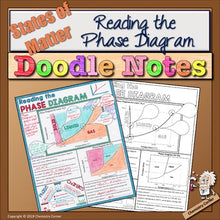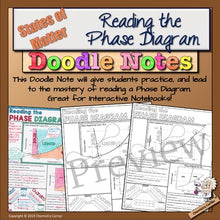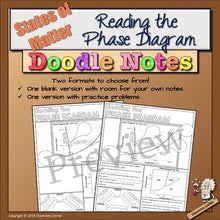With this doodle students will practice and master reading the phase diagram for two different substances. They will associate energy changes with the changes in states of matter, and that the state of matter not only depends on temperature, but also pressure. Students will also identify the triple point and critical point on the diagram, and define both.
Students will gain so much value from these doodle notes that they will be proud of and use! The included teacher notes suggest many ways of incorporating doodle notes in your class, and includes an example suggestion for completing the doodle notes. For interactive notebooks—just print at 90%, and it will fit beautifully!
Chemistry Doodle Notes! Doodling while learning forms a connection between left brain and right brain communication and enhances learning. “Cross-brain” learning has many benefits for the student—most importantly, the activity of doodling will give your students a kinesthetic connection to core concepts.
Two versions of the notes included along with a suggested key.
Version 1: these are blank notes that leave you lots of room to add your own notes. A suggested KEY is included.
Version 2: Contains practice questions.
Choose the version best for you and your students, or use both versions depending on your classes and students.
Lesson Objectives:
-
Interpret a Phase Diagram for example substances.
-
Describe how energy (thermal), and pressure are related in changes in states of matter.
-
Identify and define the triple point.
-
Identify and define the critical point for a substance.
Prior Knowledge:
Knowledge of the states of matter with regards to particle arrangement, movement, and forces of attraction (particulars about bonding is not necessary—if you have not taught that yet).
Lesson Duration: One class period
Included in This Resource:
-
Doodle Notes- one blank doodle note, one doodle note with practice problems, and a suggested key
-
Teacher Notes
Teacher Prep Time: Just print and go!
These doodle notes are appropriate for grades 9-12 chemistry, or physical science.
You will want to use these Doodle Notes year after year!
Chemistry Corner
*************************************************************************************
Check out these other products that you may be interested in:
States of Matter & the Kinetic-Molecular Theory: Gases
States of Matter and the Kinetic Molecular Theory: Liquids
States of Matter and the Kinetic Molecular Theory: Solids
Chemistry Doodle Notes for the Year: A Growing Bundle
*************************************************************************************
LICENSING TERMS: By downloading this product, you own a license for one teacher only for personal use in your classroom. Licenses are non-transferable, meaning they cannot be passed from one teacher to another. No part of this resource is to be shared with colleagues or used by an entire grade level, school, or district without purchasing the proper number of licenses. I you are a coach, principal or district interested in transferable licenses to accommodate yearly staff changes, please contact beth@chemistrycorner.com.
COPYRIGHT TERMS: ©Chemistry Corner. Please note – all material included in this resource belongs to Chemistry Corner. By downloading, you have a license to use the material, but you do not own the material. This resource, or any portion of this resource, may not be uploaded to the internet in any form, including classroom/personal websites or network drives, unless the site is password protected and can only be accessed by students—no other teachers or anyone else on the internet.






